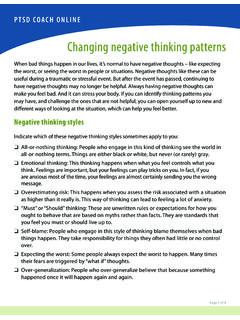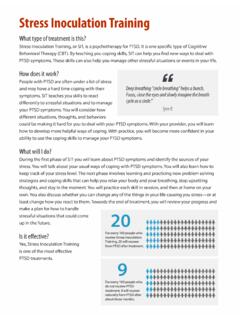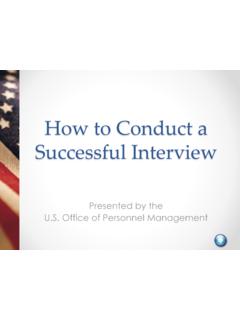Transcription of An Interview for Children: Traumatic Events Screening ...
1 ID # Clinician Date An Interview for Children: Traumatic Events Screening Inventory (TESI-C) INTRODUCTION FOR CLINICIAN INTERVIEWERS OVERVIEW The TESI-C protocol is a guide for clinical and/or research interviewing to screen for a child s history of exposure to potentially Traumatic experiences. The protocol is designed to help clinicians focus in a systematic fashion on the primary domains of trauma for children, which include direct exposure to or witnessing of severe accidents, illness or disaster, family or community conflict or violence, and sexual molestation.
2 The questions are arranged to hierarchically review experiences in an order that helps the child tolerate the possible stress of disclosing Traumatic experiences: gradually increasing the intimacy of the experiences ( , sexual trauma is reserved for the end of the Interview ) and so as to help the child recall not only physical harm/violence but also incidents of threatened harm and witnessed trauma. The Interview includes 16 items that survey the domains of potential Traumatic experiences. Each item rated YES is followed immediately with probes to determine the child and interviewer's view of the life threat/severe injury/risk of severe injury involved (OBJECTIVE) and three probes eliciting the child s appraisal of the potentially Traumatic incident(s) described for that item (APPRAISAL).
3 CLINICAL/FORENSIC USEThis protocol provides hypotheses, not a definitive identification or rule-out. All findings should be corroborated by information from independent sources. The Interview is designed for use ONLY by qualified mental health professionals or advanced trainees supervised by a qualified mental health professional. The critical qualifications are: Licensure for independent practice in child assessment and psychotherapy Supervised experience in assessment or psychotherapy with child survivors of trauma and their families The protocol should not supersede clinical judgment in making the following judgments to ensure that all relevant data are obtained and that the child is not retraumatized in the process.
4 If a child s affective or behavioral state or level of distress warrants either pausing from or discontinuing the protocol or doing a more detailed inquiry than provided in the protocol If event(s) that do not qualify as DSM-IV Criterion A traumata still warrant clinical exploration ( , exposure to sexualized activities not covered by items #12 and 13; family separation due to divorce) ADMINISTRATION and SCORING (A) ask the initial question verbatim, and follow with open-ended probe questions to clarify EACH incident (B) ask the additional question(s) verbatim, again following up with open-ended probes for EACH incident (C) elicit sufficient information to make an informed choice among the rating options: YES = child describes one or more incidents of the type defined by the question; NOTE that a "YES" does NOT automatically indicate Traumatic exposure.
5 Trauma requires determination of life/physical threat (Criterion A1) and subjective fear, helplessness, or horror (Criterion A2) by the specific probe questions that follow. NO = child states that s/he has not experienced any incident of the type defined. If no other information indicates such an incident, continue to the next TESI-C item. NOT SURE = insufficient information for YES or NO; gather additional data if possible If no further information indicates such an incident, continue to the next TESI-C item. REFUSED = child responded pass or otherwise refused to answer the question(s) If no other information indicates such an incident, continue to the next TESI-C item.
6 TESI-C The National Center for PTSD Dartmouth Child Trauma Research GroupJanuary 31, 2008page 1 An Interview for Children: Traumatic Events Screening Inventory (TESI-C-BriefForm)QV: QUESTIONABLE VALIDITY = child s credibility as historian or circumstances cause reasonable doubt [Provide written explanation in space provided just below the rating boxes for that item] TESI-C The National Center for PTSD Dartmouth Child Trauma Research GroupJanuary 31, 2008page 2 An Interview for Children.
7 Traumatic Events Screening Inventory (TESI-C-BriefForm) INTRODUCTION FOR CLINICIAN INTERVIEWERS (continued) (D) Use closed-ended probes to definitively indicate the following key trauma-specific information: OBJECTIVE HARM/THREAT according to Child = child's view of whether serious harm did or could have occurred. Mark "YES" for each event endorsed by child. Mark "YES" if child's open-ended responses clearly indicate s/he views the event as causing/threatening death/severe physical harm. Ask the specific probe question only if child's open-ended answer does not clearly give this information.
8 Mark "NO" if the child does not indicate the event involved or threatened severe harm/death. OBJECTIVE HARM/THREAT according to Interviewer = based on a careful review of the incident with the child, answer "YES" if you judge the event caused or threatened severe physical harm/death to ANYONE involved, and "NO" if you judge the event did not cause or threaten harm/death to ANYONE involved. SUBJECTIVE APPRAISAL of extreme fear = Mark "YES" if the child's open-ended answer or response to the specific probe question indicates s/he felt extreme fear in or immediately following the incident.
9 Mark "NO" if the child specifically says s/he did not feel extreme fear, in response to the probe question. SUBJECTIVE APPRAISAL of helplessness = Mark "YES" if the child's open-ended answer or response to the specific probe question indicates s/he felt helpless in or immediately following the incident. Mark "NO" if the child specifically says s/he did not feel helpless, in response to the probe question. SUBJECTIVE APPRAISAL of horror = Mark "YES" if the child's open-ended answer or response to the specific probe question indicates s/he felt sick, disgusted, or horrified in or immediately following the incident.
10 Mark "NO" if the child specifically says s/he did not, in response to the probe question. If information provided in answers to subsequent questions indicates a need for clarification and possible revision of the rating of a prior question, it is appropriate to return and, if necessary, modifythe rating of the earlier question. If more than one event or experience is described for any item: (a) Use open-ended probes to clarify the nature and impact of each incident (b) Repeat/record the OBJECTIVE and APPRAISAL questions separately for each event. Research Uses of Data from this Interview Follow-up probes are provided for all questions and at the end of each Event Section and at the end of the Interview to permit a determination of whether each identified event qualifies as a Traumatic stressor based upon the American Psychiatric Association s Diagnostic and Statistical Manual (DSM-IV) definition of post- Traumatic stress disorder.












